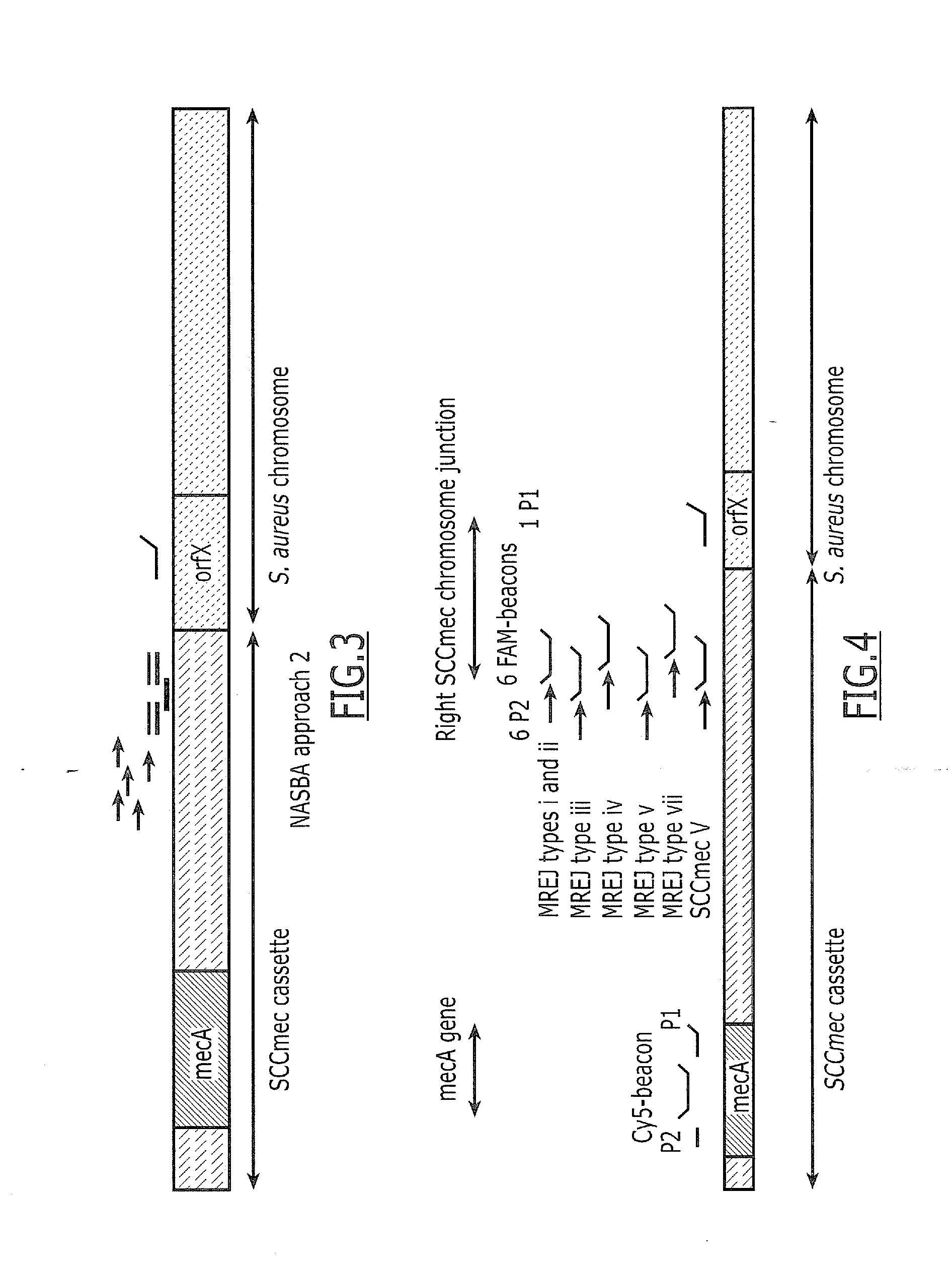Detection of Methicillin-Resistant Staphylococcus aureus
- Summary
- Abstract
- Description
- Claims
- Application Information
AI Technical Summary
Benefits of technology
Problems solved by technology
Method used
Image
Examples
example 1
NASBA Results Obtained with Approach 1 (Generic Beacon NASBA) on 21 MSSA Strains
[0155]“Approach 1” is based on the use of 5 P2 located in the right part of the cassette, one generic P1 located in S. aureus orfX and one generic beacon located in S. aureus orfX (FIG. 2). A DNA NASBA was performed using five SCCmec cassette-specific Primers 2 (P2) (SEQ ID NO: 1, SEQ ID NO: 2, SEQ ID NO: 3, SEQ ID NO: 4, SEQ ID NO: 5), one generic P1 (SEQ ID NO: 13) and one generic FAM-labeled beacon (SEQ ID NO: 18) NASBA curves were obtained for MRSA (6 strains belonging to MREJ types i, ii, iii, iv, v and vii) and MSSA. Lysate input corresponds to 105 CFU per NASBA. Max signal ratio (ratio between final signal and initial background) are given in Table 2. This experiment shows positive max signal ratio for 5 out of 21 MSSA strains (24%) with the generic beacon NASBA (approach 1).
TABLE 2max signal ratio obtained for MSSA with generic beacon NASBAstrainMax signal ratioMSSA 101.01MSSA 11MSSA 121.02MSSA 1...
example 2
NASBA Results Obtained with Approach 2 (Specific Beacons NASBA) on 6 MRSA Strains and 18 MSSA Strains
[0156]To overcome non specific detection of MSSA, “approach 2” was defined and developed. Specifically, beacons located in the right part of the SCCmec cassette instead of in the orfX) were defined. “Approach 2” uses five specific Primers 2 (P2) and one generic P1, but five specific beacons located in the right part of the cassette are used instead of a generic beacon (see FIG. 3).
[0157]A DNA NASBA was performed using five SCCmec cassette-specific primers 2 (P2) (SEQ ID NOs: 1-5), one generic (orfX primer 1 (P1) (SEQ ID NO: 13) and five SCCmec cassette-specific FAM-labeled beacons (SEQ ID NO: 7, SEQ ID NO: 8, SEQ ID NO: 9, SEQ ID NO: 10, SEQ ID NO: 11). Six MRSA and 18 MSSA strains were tested using a lysate as target corresponding to 105 CFU per NASBA. NASBA curves were obtained on MRSA and MSSA. Max signal ratio obtained are given in Table 3.
[0158]This experiment shows that only on...
example 3
Multiplex Amplification and Detection of mecA Gene and Cassette Insertion Region
[0159]Using approach 2, some false positives are eliminated, thus providing an improved method for detecting MRSA. However, MSSA strains possessing the cassette without the mecA gene can be detected, and a further improvement was investigated. As shown in this example, simultaneous amplification and detection of both the insertion cassette region, using approach 2, and the mecA gene (see FIG. 4) can help reduce detection of such strains (false MRSA positive).
[0160]This example shows the feasibility of a multiplex NASBA for detection of both the mecA gene and the cassette junction region (approach 2, which has SCCmec cassette-specific beacons) in the same tube. This NASBA makes use of 5 SCCmec cassette-specific P2 (SEQ ID NOs: 1-5), 1 P1 (SEQ ID NO: 13) and 5 FAM-labeled SCCmec cassette-beacons (SEQ ID NOs: 7-11) for the cassette junction region and 1 P1 (SEQ ID NO: 15), 1 P2 (SEQ ID NO: 16) and 1 ROX-lab...
PUM
| Property | Measurement | Unit |
|---|---|---|
| Electrical resistance | aaaaa | aaaaa |
Abstract
Description
Claims
Application Information
 Login to View More
Login to View More - R&D
- Intellectual Property
- Life Sciences
- Materials
- Tech Scout
- Unparalleled Data Quality
- Higher Quality Content
- 60% Fewer Hallucinations
Browse by: Latest US Patents, China's latest patents, Technical Efficacy Thesaurus, Application Domain, Technology Topic, Popular Technical Reports.
© 2025 PatSnap. All rights reserved.Legal|Privacy policy|Modern Slavery Act Transparency Statement|Sitemap|About US| Contact US: help@patsnap.com



